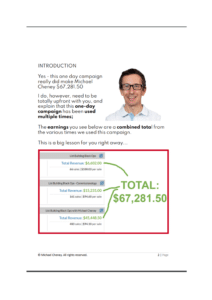Understanding the Importance of Lead Magnets
Lead magnets serve as critical tools for businesses to capture and convert leads, as they offer valuable incentives or offers to potential customers in exchange for their contact information. This exchange of information not only facilitates the initiation of communication with potential leads but also plays a vital role in nurturing and converting them into customers. For instance, a business offering a free e-book on digital marketing in exchange for a prospect’s email address can subsequently use this contact information to engage the prospect through targeted email campaigns, ultimately driving them through the sales funnel and converting them into paying customers.
In addition to their role in lead capture and conversion, lead magnets also contribute to the establishment of trust and authority for businesses within their respective industries. By providing valuable resources or incentives, businesses can position themselves as knowledgeable and reliable sources, thereby enhancing their credibility and influence among potential customers. For example, a company offering a free webinar on financial planning can demonstrate its expertise and willingness to assist potential customers, thereby building trust and authority within the financial services sector.
Moreover, successful lead magnet campaigns from prominent companies such as HubSpot, Dropbox, and Buffer underscore the importance and effectiveness of lead magnets in lead generation and conversion. By offering high-perceived-value incentives in exchange for contact information, these businesses have successfully demonstrated the impact of lead magnets in engaging potential customers and driving conversions, highlighting the significance of well-executed lead magnet strategies in achieving marketing objectives and business growth.
 Creating Effective Lead Magnets
Creating Effective Lead Magnets
In the creation of effective lead magnets, businesses should focus on defining their target audience and crafting high-quality, problem-solving content that directly addresses the needs and pain points of potential customers. For instance, a company targeting small business owners may create a comprehensive checklist for optimizing social media presence, providing practical solutions and valuable insights tailored to the specific challenges faced by their target audience. By aligning the content of the lead magnet with the interests and requirements of potential leads, businesses can enhance the appeal and relevance of their offerings, ultimately driving higher conversion rates and lead generation success.
Furthermore, the simplicity and conciseness of lead magnets, coupled with attention-grabbing headlines and compelling calls-to-action (CTAs), are essential factors for maximising their effectiveness in capturing and converting leads. Clear and concise messaging, complemented by persuasive CTAs, can drive potential customers to take the desired action, whether it involves downloading a resource, signing up for a webinar, or accessing exclusive content. For example, a succinct and compelling headline for a lead magnet can pique the interest of potential customers, prompting them to engage with the offer and provide their contact information in exchange for the incentive.
Additionally, continuous testing and refinement of lead magnet strategies based on customer feedback and performance data are crucial for ensuring their effectiveness and relevance to the target audience. By gathering insights from customer interactions and analysing the performance of lead magnets, businesses can iteratively improve and adapt their offerings, ensuring that they remain aligned with the evolving needs and preferences of potential customers. This iterative approach enables businesses to refine their lead magnet strategies, enhancing their appeal and impact, ultimately driving higher conversion rates and lead generation success.

If you’ve been struggling online this report will open your eyes.
Best Practices for Optimizing Lead Magnet Conversion Rates
Optimising lead magnet conversion rates involves considering various factors that influence their success, including problem-solving capabilities, simplicity, relevance to the business, and the fulfilment of promises. By addressing these key factors, businesses can enhance the attractiveness and effectiveness of their lead magnets in capturing and converting leads, thereby driving meaningful engagement and conversion within their target audience.
Moreover, strategies for optimising landing page design and content, such as testing different offerings and utilising exit-intent pop-ups, can significantly enhance conversion rates. Tailoring the content and design of landing pages to align with the preferences and needs of potential customers can create a more compelling and persuasive user experience, increasing the likelihood of lead capture and conversion. For example, a business offering a lead magnet in the form of a free trial may use an exit-intent pop-up to capture the attention of potential customers who are about to leave the page, providing them with an additional opportunity to engage with the offer and provide their contact information.
Additionally, the removal of distractions from the page and the incorporation of additional features can further improve the performance of lead magnets, creating a more streamlined and compelling experience for potential customers. By creating a focused and immersive experience for potential leads, businesses can reduce friction and distractions, guiding potential customers towards the desired conversion action and driving higher lead capture and conversion rates.
Furthermore, understanding the target audience and creating buyer personas are essential steps in lead generation optimization, as they enable businesses to tailor their lead magnet offerings to the specific needs and preferences of potential customers. By developing valuable offerings, creating irresistible opt-in forms, and leveraging content upgrades, businesses can enhance the appeal and impact of their lead magnets, ultimately driving higher conversion rates and lead generation success. For example, a company providing a comprehensive guide to sustainable living may create an interactive quiz to complement the lead magnet, engaging potential customers and providing them with valuable insights tailored to their interests and lifestyle choices.

Become the Internet Marketing Millionaire’s Next Apprentice!!
Designing Compelling Call-to-Actions and Landing Pages
The design of attention-grabbing and persuasive call-to-action buttons, as well as visually appealing and user-friendly landing pages, is crucial for the success of lead magnets. By incorporating social proof and trust signals, such as customer testimonials and endorsements, businesses can further enhance the effectiveness of their lead capture forms and landing pages, instilling confidence and credibility in potential customers. For example, a company offering a lead magnet in the form of a free e-book may include testimonials from satisfied readers, highlighting the value and impact of the resource, thereby encouraging potential customers to engage with the offer and provide their contact information.
Moreover, the use of compelling imagery and persuasive copy also plays a significant role in shaping the performance of call-to-actions and landing pages, influencing the decision-making process of potential leads. Engaging visual elements and persuasive messaging can create a compelling and immersive user experience, capturing the attention of potential customers and guiding them towards the desired conversion action. For instance, a business offering a lead magnet in the form of a webinar may use captivating visuals and compelling copy to communicate the value and relevance of the event, prompting potential customers to register and provide their contact information.
Additionally, implementing personalised email campaigns, segmenting and targeting leads, and automating lead nurturing processes are integral to lead generation optimisation, as they enable businesses to deliver tailored and relevant content to potential customers, driving engagement and conversion. By leveraging the power of personalised communication and automated workflows, businesses can nurture and convert leads effectively, guiding them through the sales funnel and ultimately driving higher conversion rates and lead generation success.

Promoting Lead Magnets Effectively
Promoting lead magnets effectively involves making them visible on the website and strategically offering them at the right time to maximise their visibility and impact in capturing leads. By strategically placing lead magnets within the website’s navigation and content structure, businesses can increase their visibility and accessibility, ensuring that potential customers encounter these incentives at key touchpoints in their journey. This strategic approach can enhance the effectiveness of lead magnets in capturing leads and driving meaningful engagement.
Leveraging social media and email marketing to promote lead magnets can expand their reach and engagement with the target audience, increasing the likelihood of lead capture and conversion. Businesses can harness the power of social media platforms and email campaigns to amplify the visibility and impact of their lead magnets, reaching a wider audience and driving higher levels of engagement and conversion. For example, a company promoting a lead magnet in the form of a free resource guide may utilise targeted social media ads and email newsletters to reach potential customers and encourage them to engage with the offer.
Furthermore, partnering with influencers and collaborating on promotional campaigns can amplify the visibility and impact of lead magnets, leveraging the influence and reach of key personalities to attract potential customers and drive conversions. By aligning with influencers who resonate with their target audience, businesses can expand the reach and impact of their lead magnets, leveraging the credibility and influence of these personalities to drive higher levels of engagement and conversion. For instance, a business collaborating with a prominent influencer in the fitness industry to promote a lead magnet on healthy living can tap into the influencer’s audience, driving increased visibility and engagement with the incentive.
Moreover, businesses should consider the implications of future advancements for optimising lead magnet performance, as they prepare for the evolving landscape of lead generation and conversion rate optimisation. By staying informed about emerging trends and technologies, businesses can position themselves to adapt and leverage these advancements to enhance the effectiveness of their lead magnets, ultimately driving higher conversion rates and lead generation success. For example, a company exploring the potential of AI and machine learning in lead generation may develop strategies to incorporate these technologies into their lead magnet campaigns, leveraging advanced data analysis and personalisation to drive meaningful engagement and conversion.
Leveraging Data and Analytics for Optimization
Tracking and monitoring key performance indicators related to lead magnet performance is essential for identifying areas of improvement and success. By leveraging data and analytics tools, businesses can gain valuable insights into the performance of their lead magnets, identifying strengths and areas for improvement, thereby refining their strategies to enhance the impact and effectiveness of their lead magnet campaigns.
A/B testing landing pages and forms provides valuable insights into the most effective strategies for increasing conversion rates, allowing businesses to refine their approach and maximise the impact of their lead magnets. By testing different variations of landing pages and forms, businesses can gather empirical data on the performance of their lead magnet offerings, enabling them to make informed decisions and iterate on their strategies to drive higher levels of engagement and conversion.
Using data and analytics to continuously measure and optimise lead magnets is crucial for ongoing success and improvement, enabling businesses to adapt to changing dynamics and refine their lead generation strategies for optimal performance. By adopting a data-driven approach to lead magnet optimisation, businesses can continuously measure, analyse, and refine their strategies, ensuring that their lead magnets remain relevant and impactful, ultimately driving higher conversion rates and lead generation success.
Integrating Lead Magnets into the Overall Conversion Rate Optimization Strategy
Aligning lead magnets with the sales funnel and segmenting the audience can maximise their impact in converting leads into customers. By integrating lead magnets into the overall conversion rate optimisation strategy, businesses can effectively leverage these incentives to build trust, personalise the customer experience, and continuously measure and optimise their performance for sustained success. This strategic alignment ensures that lead magnets are seamlessly integrated into the customer journey, driving meaningful engagement and conversion at every stage of the sales funnel.
Continuously measuring and optimising the integration of lead magnets into the overall strategy is vital for sustained success in conversion rate optimisation, ensuring that businesses remain responsive to changes in customer behaviour and market dynamics. By monitoring and refining the integration of lead magnets into their conversion rate optimisation strategy, businesses can adapt to evolving trends and preferences, driving higher levels of engagement and conversion, ultimately maximising the impact and effectiveness of their lead magnet campaigns.
Common Mistakes to Avoid with Lead Magnets
Identifying and avoiding mistakes such as offering something of low value, ineffective promotion, and not integrating lead magnets into the overall strategy is crucial for success. By recognising and mitigating these common pitfalls, businesses can safeguard their lead magnet campaigns against factors that can hinder their effectiveness and impact, ultimately driving higher levels of engagement and conversion.
Ensuring the effective use of landing pages and thorough testing of lead magnets is essential for maximising their impact on conversion rates, safeguarding businesses against pitfalls that can hinder their lead generation and conversion efforts. By focusing on the quality and optimisation of their landing pages, businesses can create a compelling and persuasive user experience, driving higher levels of engagement and conversion, thereby maximising the impact and effectiveness of their lead magnet campaigns.
Integrating lead magnets into the overall conversion rate optimisation strategy is necessary to avoid pitfalls and achieve sustainable success in lead generation, underscoring the importance of a holistic and cohesive approach to maximising lead magnet performance and conversion rates. By aligning their lead magnets with their broader conversion rate optimisation strategy, businesses can ensure that these incentives play a central and impactful role in driving engagement and conversion, ultimately achieving sustained success in lead generation and customer acquisition.
 Future Trends and Advancements in Lead Magnets and Conversion Rate Optimization
Future Trends and Advancements in Lead Magnets and Conversion Rate Optimization
Exploring upcoming trends such as AI and machine learning, interactive lead magnets, and video lead magnets can provide insights into the future of lead generation and conversion rate optimisation. By considering the potential impact of these advancements, businesses can position themselves to adapt and leverage emerging technologies, ultimately driving higher levels of engagement and conversion, ensuring that their lead magnet campaigns remain relevant and impactful in a rapidly evolving marketing landscape.
Considering the implications of future advancements for businesses seeking to optimise lead magnet performance is crucial for staying ahead of the competition and adapting to changing consumer behaviours. By anticipating and preparing for the impact of emerging trends and technologies, businesses can proactively refine and adapt their lead magnet strategies, ensuring that they remain responsive to the evolving needs and preferences of potential customers, ultimately driving higher levels of engagement and conversion.
Moreover, the exploration of future trends and advancements in lead magnets and conversion rate optimisation enables businesses to position themselves as early adopters of innovative strategies and technologies, thereby gaining a competitive advantage in lead generation and customer acquisition. By staying ahead of the curve and leveraging emerging trends, businesses can drive higher levels of engagement and conversion, ultimately maximising the impact and effectiveness of their lead magnet campaigns.
 Conclusion and Call to Action
Conclusion and Call to Action
In conclusion, the effective utilisation of lead magnets is essential for businesses seeking to maximise lead generation and conversion rates, as they offer valuable incentives that drive meaningful engagement and conversion within their target audience. By encouraging readers to explore Affiliate Success Secrets for further resources and information on affiliate marketing, including practical strategies for lead magnet success, businesses can empower themselves with valuable insights and actionable recommendations to enhance their lead magnet performance and overall conversion rates.
For more in-depth insights and practical strategies to optimise lead magnet performance and achieve sustained success in lead generation, readers are invited to visit the Affiliate Success Secrets website. Through continuous learning and adaptation, businesses can elevate their lead generation efforts and drive enhanced conversion rates, establishing a strong foundation for long-term success in the competitive landscape of digital marketing and customer acquisition.


 Creating Effective Lead Magnets
Creating Effective Lead Magnets Future Trends and Advancements in Lead Magnets and Conversion Rate Optimization
Future Trends and Advancements in Lead Magnets and Conversion Rate Optimization Conclusion and Call to Action
Conclusion and Call to Action